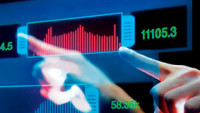 European and US markets continued their August angst yesterday on a continued combination of weak oil prices and bank share prices, as well as disappointment over the latest attempts by global policymakers to try and boost sentiment.
European and US markets continued their August angst yesterday on a continued combination of weak oil prices and bank share prices, as well as disappointment over the latest attempts by global policymakers to try and boost sentiment.
The day began with the Reserve Bank of Australia cutting rates further into record low territory to 1.5%, no doubt in an attempt to pre-empt a potential rate cut next week by the RBNZ, but also to try and keep a lid on the Australian dollar, given that it seems unlikely that the Fed will raise rates this year. What they can’t have envisaged was that in so doing the Australian dollar would finish the day higher as investors surmised that they would be hard pressed to mitigate any inaction by US policymakers.
This was followed by markets taking one look at Japanese PM Shinzo Abe’s new stimulus program, or the markets worst kept secret, in the process giving it the equivalent of a great big “nothing to see here and we’re walking” moment, as Japanese policymakers passed up yet another opportunity to implement some significant structural reforms.
The larger concern here given recent market reaction to policy moves by central bankers is that policymakers are losing the confidence of investors.
Investors are slowly realising that with every spin of the central bank policy chamber the magazine is getting emptier, and in the absence of any will or ability of politicians to step up, central bank policy will continue to move into the realms of the more experimental with every passing day.
If last week’s European bank stress tests were designed to bolster confidence in the European banking sector it is becoming quite clear that they have failed abysmally. Far from boosting confidence they appear to have helped undermine it by focussing attention on what wasn’t tested, as opposed to what was.
The omission of Portuguese and Greek bank from the tests as well as the failure to test resilience against a prolonged period of negative rates has left investors to draw their own conclusions, and Commerzbank’s decision yesterday to scrap its profit target for the year in the wake of 32% drop in quarterly profits, merely served to reinforce those fears sending its share price to new record lows, along with its sector peer Deutsche Bank, who suffered the ignominy of being relegated out of the EurStoxx50 in a clear sign of how far the shares have fallen.
Italian banking shares also resumed their downward track despite Italian Prime Minister Matteo Renzi’s attempts to calm nerves by claiming that Italian banks were fine by claiming that growth would be the best way to resolve the NPL problem.
Unfortunately for Mr Renzi the Italian economy hasn’t grown in any significant way since it joined the euro which suggests that for all his warm words the reality has been somewhat different, and isn’t likely to change any time soon, and that is likely to be his biggest challenge.
Monte dei Paschi led the declines crashing to new record lows and weighing down the rest of the sector as doubts grew about the prospect of the ability of the Italian banking sector to absorb further write downs across the rest of the sector.
Today’s focus returns to the latest economic data, this time on the services side with the latest July services PMI data for Spain, Italy, France, Germany and the UK.
While expectations for the PMI’s in Europe are expected to show a slight moderation from the June numbers it is the UK numbers which will be of particular interest given the sharp decline to 47.4 in the flash numbers two weeks ago.
UK services PMI for July is expected to remain at the 47.4 levels seen between 12th and the 21st July, however given the stabilisation in the political climate seen since mid-July there is the outside possibility that these might improve. A further deterioration here would certainly raise the stakes further for tomorrows Bank of England rate decision, where expectations remain high that we’ll see a cut in rates for the first time in seven years.
EURUSD – continues to ratchet higher having moved above the 1.1200 area, with a move beyond 1.1250 arguing for a retest of the June highs at 1.1400. We have interim support at 1.1180 as well as 1.1120. To remove the risk of a move towards 1.0825 we need to see a move back above the 1.1250 area.
GBPUSD – continues to hold above trend line support from the lows this year, now at 1.3150 and having broken through 1.3300 looks set for a move back towards the range highs near 1.3500, and possibly even 1.3650. A move below 1.3050 would negate, and argue for a return towards 1.2800.
EURGBP – another failure at the 0.8500 area brings the support back at the 0.8400 level into focus. Above the 0.8500 level argues for a return to the July peaks at the 0.8600 area. Below the 0.8400 area reopens the support at the 0.8260 area.
USDJPY – continues to track lower and having pushed back below the 103.50 area looks set for a look at the 100.00 level, as well as the recent lows at 98.95. We need to see a recovery back through the 103.70 area to stabilise and argue for a move towards the 105.60 level.












